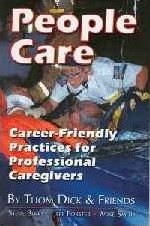Let’s just get it out of the way. As a Basic EMT, and to a slightly lesser but still very similar extent as a Paramedic, you are typically viewed as unskilled rank-and-file. You are more like the kid flipping burgers at Burger King than a nurse or a doctor. This is a consequence of supply vs. demand, low barriers to entry in this business, and minimal labor and political representation. I don’t think it’s right, but it is the way it is.
(Note: those working for fire departments and other public services may find that this information does not apply. If that describes you, I applaud you for your good fortune. But for the thousands employed with private services, read on.)
This is a difficult and personal subject for me. The start of my career was a rocky one; there were various factors, but in the end, the one overarching reason was that I didn’t understand how to be the kind of EMT that employers wanted. The lessons that follow may not apply everywhere, but based on my experiences with numerous companies in two different geographical areas, they are generally more true than not, and if you’re newly entering this industry in a field position, they’re worth holding close to your heart.
First, understand that, as we noted, you are not a high-value employee. In fact, you are essentially a low-wage service worker, and you are largely interchangeable with anyone who holds the same certification. Moreover, the job market is currently Bad, and even when it was better, there were people out there who would do this job for free; in other words, even though demand for your skills is still reasonable, supply is very high. Although your service needs a certain number of EMTs and/or paramedics, and although they may perform some amount of screening or testing to find the best candidates (better employers will do more of this), as a general rule there is a limitless supply of people standing behind you, all holding the same card. And your company is just as willing to pay them instead of you.
Second, your employer is in the business of making money. Just like BK needs someone to flip their burgers, ambulance companies need someone to drive and tech their ambulances, so you are a necessary part of their business model. But you are far from unique or irreplaceable. Since it’s not very difficult to hire an EMT, it’s never very difficult to fire one and hire another. So if you ever become more trouble to keep around than you’re worth, you’re inching towards termination.
Third, and most importantly, the money is in the money. A principled and respectable private service will try to drive their financial success through clinical excellence, but whether they do or not, their financial success remains the bottom line. Your Lifepaks and MDTs may or may not get upgraded, but the marketing and PR is never in question. So if by your actions, inaction, or even by association you’re ever involved with something that jeopardizes your company’s revenue stream, you’re absolutely begging them to reconsider taking their chances on a fresh hire.
So, do you want to keep this job, be it briefly or for a long career? (Whether you should be taking advice from me is a fair question, but at least you’re hearing it from experience at the wrong end of every error.) Job stability in this field depends on three skills, and you don’t need them all. Pick any two and you’ll do okay. You might even sneak by with just one. But when the day comes that you don’t have any to protect you, your days are numbered.
1. Protect the Money
You can kill patients, break equipment, curse like a sailor, and drive rigs off cliffs, but if you can avoid impacting your employer’s bottom line, you’ll probably be fine.
Billing is big. Try your hardest to help generate billable runs, because getting paid for your calls is how money is made, and consistently interfering with this will bring you the wrong sort of attention. Whatever documentation hoops they ask you to jump through, as long as they’re not unethical or detrimental to patient care, just do it.
Furthermore, your company’s continued existence is predicated on maintaining certain contracts that it holds with cities, counties, hospitals, and other facilities. These contracts give your company the right to transport some or all of their patients, and that can mean many calls and many dollars per year. If you look unprofessional to someone important, piss off a staff member, or make a clinical error that comes to the wrong person’s attention, you are making the Powers That Be at that organization wonder if they shouldn’t be handing their patients and dollars to a different ambulance company. And that is numero uno on the list of ways to lose your job. Don’t think that the facts will save you, and don’t think that they’ll be reasonable or go to bat for you, because if being able to say “the people responsible have been terminated” is good for business, then nothing else will matter.
Play the game. If you’re asked to wash the truck with a toothbrush, wear a tie and a monocle, and give all of your patients free backrubs, just do it. Play the game, or someone else will.
2. Be Liked
They never taught you this in school (and school was where you’d have found many of us just before we became EMTs), but if the right people like you, nearly anything is possible. If not…
You don’t have to be universally popular, but you should not be “that guy,” because when push comes to shove, somebody with an office and a salary is going to have to decide whether you should keep working here, and if they never liked you to begin with you’re not going to have any armor.
Here’s the big, big secret. You may think that life should be fair, or at least employment should, and if you do your job and don’t screw up too big, there’s no grounds to fire you. In other jobs, you might be right. But we just saw that you hold no sway in these parts, cowboy. Moreover, in most places you were hired under a contract that included the words “at will,” which means they can get rid of you for no reason at all. (Wholly legal? Maybe, maybe not, but most of us won’t be bringing any lawsuits, because it’s a lot of trouble and being “the dude who sued” is not great for your future employability.) So here’s the way it really works: they can terminate anyone, or they can keep anyone. It all depends on what they want to do.
If you’re well-liked by the people who have a say, then you can screw up, and it will be water under the bridge. It may be documented and recorded, or it may simply be swept aside, but nothing will come of it. On the other hand, if you’re someone they’d rather no longer worked there, then you don’t even need to screw up to find your way to the chopping block. Because the fact is, nobody is perfect; even if you think you’re a company man, in the 40+ hours you punch each week, they can find a violation here, an error there, a complaint, a concern. If you ever start getting called to the deck for driving 26 in a 25 MPH zone or parting your hair left instead of right, update your resume, because this is known as “building a paper trail.” (If you’re lucky, maybe they have no problem with you yet, and they’re just preparing a case for the future. Some places are optimistic like that.)
3. Stay Under the Radar
This is the master key of maintaining your employment. Many people lack one or both of the previous virtues, but still keep their job for 10 years because they’ve got this one down pat.
If you’re hired today, and starting tomorrow nobody ever hears your name again, then your job is safe. Your name has to cross someone’s desk before they can tie you a noose. So if you’re ever going to screw up, just make sure that it’s never in a way that draws attention.
EMS is rife with uniformed men and women who show up, clock in, work their hours, and go home. They may be interesting people or boring ones, smart or dumb, up-and-coming or cheerfully stagnant. They may be loved or hated by their coworkers. They may even give bad care, write bad documentation, and draw ire in every ED they enter. But so long as it’s never the kind of thing to make anybody complain to the supervisors, then they’ll do just fine.
On the flip side, they might be a Super EMT, aces in every category, but if their name and face are constantly attracting the eye of the bosses, then they’re at best one or two steps from seeking new employment. Because being a bother is not a good virtue if you’re not valuable.
Truth be told, if you’re wise, then you’ll probably stay off the radar even for the most harmless reasons. No attention is good attention, not even asking to change a shift or replace a shirt, and while some of that is obviously necessary it should certainly be minimized. It’s a fine, fine art you’ve mastered when you’re hired as a new medic, and five years later nobody upstairs knows you beyond a vague sense that might work there.
There you have it. The big three.
You will notice that nowhere in the above list do I include clinical competence. For a long time, I believed that if you were a good EMT, that was enough to keep you safe — and if you were an exceptional EMT, that would even make up for a few things. This couldn’t be further from the truth. Possibly in a few cases, such as if you assist with training and continuing education, your knowledge and skills can be a feather in your cap. But as a rule, nobody in charge knows or cares about how good you are. You’re just one of the many EMT-Bs or EMT-Ps from the big group of identical licenses on the payroll. So if you think that being the fastest intubator in the West will protect you from violations of the Big Three, then you are sadly mistaken.
Indeed, this is yet another reason (you know, beyond the basic moral ones) to treat your patients and facility staff with respect and compassion. By and large, they don’t know if you’re any good at medicine — the patient in particular — but they know if you were a dickhead, and dickheads are the people they call and complain about. You can nearly kill someone, but if you smile, hand them a warmed blanket, and shake their hand, they’ll go away thinking you were the nicest young man they ever met. For all the great ideas on kindness and empathy in our favorite EMS book, Thom Dick’s People Care, it’s worth noting that its subtitle is not “How to Get into Heaven,” but “Career-friendly Practices for Professional Caregivers.” Career-friendly indeed.
It may sound like I’ve become a terrible cynic, but in truth, I think I’ve just come to understand the basic realities of the field we work in. We may wish the world were different, but we may also wish for a pet unicorn and world peace; things are the way they are, and the truth is that you should be able to maintain a long and successful career, providing the most outstanding care you can offer, if you simply learn how to stay employable.


Recent Comments